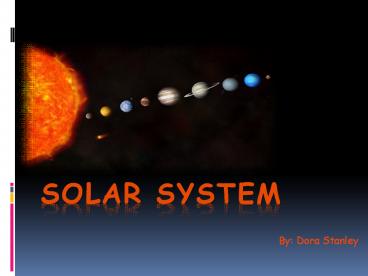The Solar System - PowerPoint PPT Presentation
Title:
The Solar System
Description:
A tour of our solar system. – PowerPoint PPT presentation
Number of Views:8622
Title: The Solar System
1
Solar System
- By Dora Stanley
2
The Sun
- The Sun is a yellow dwarf star. It is the star
in the middle of the solar system. It is almost
perfectly spherical and consists of hot plasma
interwoven with magnetic fields. The Sun has a
diameter of about 1,392,000 km. The temperature
of the Sun ranges from 4,100K to 20,000,000K.
3
Mercury
- Mercury is innermost and smallest planet in the
solar system. It orbits the Sun once every
87.969 Earth days. The orbit of Mercury has the
highest eccentricity of all the solar system
planets. It has the smallest axial tilt. Its
rotation is so slow it only rotates on its axis 3
times for every two orbits of the sun.
4
Venus
- Venus orbits the Sun every 224.7 Earth days.
Venus is named after a Roman goddess of love and
beauty. Its elongation reaches a maximum of
47.8. Venus reaches its maximum brightness
shortly before sunrise or shortly after sunset.
Venus is sometimes called the Morning Star or
Evening Star.
5
Earth
- Earth is the fifth largest planet in the solar
system. Earth was formed 4.54 billion years ago.
Life appeared on its surface within one billion
years. About 71 of the surface is covered with
salt water oceans. Earths only known satellite
is the Moon which began orbiting it about 4.53
billion years ago.
6
Mars
- Mars is named after a Roman god of war. Its the
fourth planet from the sun. Its described often
as the Red Planet. Mars is a terrestrial planet.
It has a thin atmosphere.
7
Jupiter
- Jupiter is the largest planet in the solar
system. It is a gas giant. The Great Red Spot
is an anticyclonic storm that is larger than
Earth. Jupiter is primarily composed of
hydrogen. A quarter of its mass is helium.
8
Saturn
- Saturn is the second largest planet in the solar
system. It is named after the Roman god of
agriculture and harvest sector. Saturn is a gas
giant. It has an average radius of about 9 times
that of Earth. Saturn is 95 times more massive
than Earth.
9
Uranus
- Uranus has the third largest planetary radius.
It has the fourth largest planetary mass in the
solar system. Its named after the ancient Greek
deity of the sky, the father of Saturn and the
grandfather of Jupiter. Uranus revolves around
the Sun once every 84 Earth years. It is visible
to the naked eye in dark skies.
10
Neptune
- Neptune is named after the Roman god of the sea.
It is the largest planet in diameter. It is the
third largest in mass. Neptune is 17 times the
mass of Earth. Its symbol is a stylized version
of the god Neptunes trident.
11
Pluto
- Pluto is a dwarf planet. Plutos atmosphere
consists of a thin envelope of nitrogen. Plutos
atmosphere also contains methane and carbon
monoxide gases. Pluto has 4 moons named Charon,
Nix, Hydra, and s/2011/P1. Pluto is part of the
Kuiper belt.
12
Asteroids
- Asteroids are a class of small Solar System
bodies in orbit around the sun. Individual
asteroids are classified by their characteristic
spectra. The largest asteroid is the Vesta. The
Hygeias surface temperature is 164K. The Ceres
rotation period is 9.07.
Vesta asteroid
13
Meteors
- A meteor is the visible path of a meteoroid that
has entered Earths atmosphere. Meteors
typically occur in the mesosphere. Most meteors
range in altitude from 75km to 100km. Most
meteoroids that cause meteors are about the size
of a pebble. Millions of meteors occur in the
Earths atmosphere everyday.
14
Comets
- A comet is a small, icy solar system body
orbiting the sun. It consists of a nucleus,
tail, and coma. When a comet comes close to the
sun, the coma and tail become visible. As of
January 2011, there were 4,185 reported comets.
Particularly bright or notable examples are
called Great Comets.
15
Solar System
- The Solar System is located in the Milky Way
Galaxy and consists of the Sun and the
astronomical objects gravitationally bound in
orbit around it. There are 4 inner, or
terrestrial, planets and 4 outer planets called
gas giants. Beyond the outer planets, there are
dwarf planets. Other orbital bodies include
asteroids, comets, meteors, and moons.































